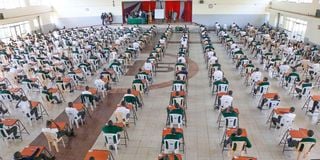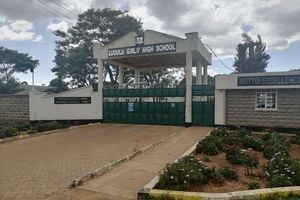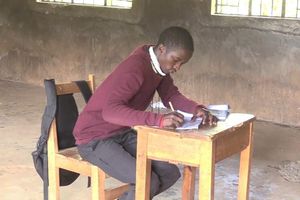Among the 2,165,041 students (50.14 per cent) who scored D+, D, and D-, slightly more females (50.17 per cent) than males (49.28 per cent) received these grades.
Some 201,573 students (4.66 per cent) scored grade E, with more males (57.71 per cent) than females (42.28 per cent) in this category.
So, what is the common denominator among the schools that churn out candidates at the bottom of the pyramid every year?
According to Kenya Secondary Schools Heads Association (Kessha) Chairman Willy Kuria, the poor performance is due to many challenges, including inadequate funding and resource constraints.
Mr Kuria noted that many schools, particularly those serving underprivileged communities, are grappling with insufficient government capitation and limited infrastructure.
“These schools lack the necessary facilities and resources to foster a conducive learning environment. The government funding, which is supposed to bridge the gap, is often delayed or incomplete, leaving schools struggling to meet basic operational needs,” he said during an interview with Nation.Africa.
According to Mr Kuria, over 48,000 students scored low grades, such as D and below, in recent examinations, a trend he attributes to systemic issues in the education sector.
He explained that many of these students come from schools facing challenges like power and water disconnections, unpaid staff, and insufficient teaching materials.
“The morale in these schools is very low. Some schools have even failed to pay non-teaching staff, including cooks and secretaries, due to financial constraints. Without adequate resources, how can we expect students to excel?” he said.
Spot-checks at various schools revealed some of the reasons why some struggle.
In Nakuru, principals in some public schools highlighted issues such as teacher shortages, lack of libraries, toilets, water, laboratories, computers, and textbooks, which hinder smooth learning.
At Elburgon DEB Secondary School, with more than 1,400 students with 26 employed by the Teachers Service Commission (TSC) while 10 are employed by the board of management (BOM), some of the issues the management raised include delayed government capitation which often forces BOM teachers to leave due to unpaid salaries.
“Due to the government’s delay to disburse the capitation in schools, some of our BOM teachers go away for lack of payments, never to come back. Schools fees for parents is also a challenge,” said an official.
Elsewhere in Nakuru, Michinda Boys High School is plagued by the absence of workshops for electricity and building construction, an under-equipped computer lab, and the need for a larger home science room.
Despite these challenges, the school offers unique technical subjects in Molo sub-county.
“I have no electricity workshop or a building and construction workshop. The school’s computer room is not well equipped and also the home science room requires expansion,” school a school official.
Performance in the area has, however, been gradually improving. In 2024, Elburgon DEB had 380 KCSE candidates, with 39 scoring C+ and above, achieving a mean score of 4.42.
Michinda Boys had 99 candidates, with 34 qualifying for university, and a mean score of 5.93.
In Kisii, Amariba Secondary School in Nyaribari Chache constituency has been under scrutiny in recent days because of poor performance.
In the 2023 KCSE examination, the school had a mean score of 2.733.
“We want the school principal transferred for he is doing little to ensure our learners get good grades. He has micro-managed our school, and this has led to the decline of the student population from 700 to 220,” said Simon Nyachiro, a parent.
In KCSE 2024, out of an entry of 60 candidates, the school managed to send only eight students to university. The top student got a mean grade of B+ (plus), while another had a B (plain). Six students got C+ while two had C plain. 11 students scored C- while 14 had D+. The school registered nine D plains, 14 D-, and two Es.
In Uasin Gishu, Lelmolwok Secondary School in Kesses recorded the highest number of Es in the 2024 KCSE, with 47 out of 106 candidates scoring the lowest grade possible. The best student managed a C plain, with most expected to join TVET institutions.
Kenya Union of Post-Primary Education Teachers (Kuppet) Secretary Elijah Maiyo attributed the performance to infrastructural challenges, urging support for students pursuing technical skills.
At AIC Kosyin in Soy, more than half of the 24 candidates scored E, with the top three achieving a D plain. At Wareng Secondary School, President William Ruto’s alma mater, had 365 out of 401 candidates qualifying for TVETs, with only six students scoring a B plain.
Uasin Gishu High School, once a top-performing day school, saw only 53 out of 364 candidates qualify for university.
Kimoning Secondary, Chebisaas Girls, and Seko Girls also recorded significant numbers of students scoring below C plain.
However, the county saw a rise in As from 115 in 2023 to 146 in 2024, according to education director John Thiringi.
In West Pokot, Cheptulel Boys faced disruptions due to insecurity, forcing candidates to learn at Surumben Primary School without proper facilities. Despite challenges, the school had a mean score of 4.071, with only two students qualifying for university.
Lodwar Boys High School in Turkana attributed its low performance to admitting students with as low as 270 marks because insecurity deters higher-performing students.
St James Pokotom Mixed Day Secondary had a mean score of 2.56, with the top student scoring C-, while Lokichoggio Mixed Secondary recorded one B- among its 22 candidates.
At St Peter Kindu Secondary School, the 2023 KCSE results painted a grim picture with a mean score of D-. The top two students managed D+ grades, while 16 scored D and 17 received E.
Despite attempts to engage the school administration for comments, they declined to speak.
Mr Zablon Awange, the Kisumu Kuppet secretary, attributed the poor performance to delayed capitation, financial struggles among students, and inconsistent attendance. He highlighted the adverse effects of arbitrary teacher transfers, stating that over 500 teachers in Kisumu were moved in January, many to Nyando or Seme, without hardship allowances.
“These transfers have demoralised teachers, and many schools have rejected posted principals, creating a rift with local communities,” said Mr Awange.
In Isiolo County, Garbatulla High School – which was a top-performing institution in the 1990s – has faced a steep decline due to insecurity. The school was closed for two years, reopening in 2002 as a district school. Recovery has been slow. In 2023, only three out of 33 candidates attained a C+ and above, compared to nine out of 42 the previous year.
The school’s challenges include dilapidated infrastructure, lack of a library and modern science labs, and low enrolment, attracting mostly local students.
The school’s principal, Mr David Ruito, said the intervention by alumni has made notable achievements among them an increased population, improved academic performance
“This school could not be in a poor state if all stakeholders were serious. If dormitories and classes are revamped, it will attract many. I am aware it is the inside that is mostly dilapidated but rehabilitation work is set to commence soon,” Mr Ruito said.
“The biggest challenge is the library, we have discussed what we can do, this being an era of technology, a school lab is ideal. We will also do linkages and proposals to donors to establish a library in this school,” said Mr Adan Kabelo, the alumni chairman.
In Kisumu County, few learners from flood-prone Nyando region achieved university entry grades in the 2024 KCSE. At Ombaka Mixed Secondary School, only two out of 74 candidates hit the pass mark, with one B- and one C+, showing a slight improvement from 2023.
Odienya, Withur, and Kanyagwal mixed secondary schools also posted low mean grades, with only two students in Kanyagwal scoring C+ or higher.
Seasonal flooding disrupts learning, damages infrastructure, and increases poverty, forcing students to work in rice fields and exposing them to waterborne diseases. Poor facilities and staff shortages further hinder performance.
At Kibos Secondary School, still in Kisumu, only 16 out of 145 students met university entry points, with the principal citing poverty and inadequate infrastructure.
Mwai Abiero Ogen Secondary School in Muhoroni had no students qualifying for university, with the top candidate scoring a C-.
According to the 2024 Economic Survey, there are 1,120 public vocational training centres, 88 private vocational training centres, 309 public technical and vocational colleges, and 1,048 private technical and vocational colleges. Additionally, there are 12 national polytechnics, all of which are public institutions.
In 2023, 642,726 students were enrolled in these institutions. That number is expected to rise, especially given the anticipated increase in enrolment following the release of the 2024 KCSE results.
Reported by Mercy Simiyu, Jackline Macharia, Daniel Ogetta, Barnabas Bii, Titus Ominde, Evans Jaola, Oscar Kakai, Sammy Lutta, Angeline Ochieng, Wycliffe Nyaberi, Elizabeth Ojina, Mwangi Ndirangu, and John Njoroge










